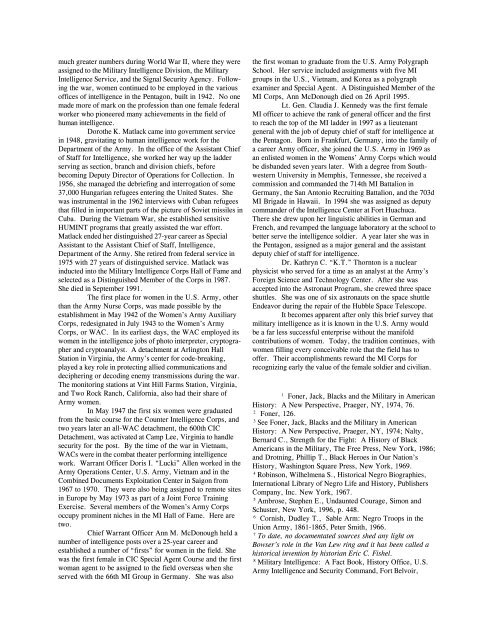Diversity in MI - Fort Huachuca - U.S. Army
Diversity in MI - Fort Huachuca - U.S. Army
Diversity in MI - Fort Huachuca - U.S. Army
- No tags were found...
Create successful ePaper yourself
Turn your PDF publications into a flip-book with our unique Google optimized e-Paper software.
much greater numbers dur<strong>in</strong>g World War II, where they wereassigned to the Military Intelligence Division, the MilitaryIntelligence Service, and the Signal Security Agency. Follow<strong>in</strong>gthe war, women cont<strong>in</strong>ued to be employed <strong>in</strong> the variousoffices of <strong>in</strong>telligence <strong>in</strong> the Pentagon, built <strong>in</strong> 1942. No onemade more of mark on the profession than one female federalworker who pioneered many achievements <strong>in</strong> the field ofhuman <strong>in</strong>telligence.Dorothe K. Matlack came <strong>in</strong>to government service<strong>in</strong> 1948, gravitat<strong>in</strong>g to human <strong>in</strong>telligence work for theDepartment of the <strong>Army</strong>. In the office of the Assistant Chiefof Staff for Intelligence, she worked her way up the ladderserv<strong>in</strong>g as section, branch and division chiefs, beforebecom<strong>in</strong>g Deputy Director of Operations for Collection. In1956, she managed the debrief<strong>in</strong>g and <strong>in</strong>terrogation of some37,000 Hungarian refugees enter<strong>in</strong>g the United States. Shewas <strong>in</strong>strumental <strong>in</strong> the 1962 <strong>in</strong>terviews with Cuban refugeesthat filled <strong>in</strong> important parts of the picture of Soviet missiles <strong>in</strong>Cuba. Dur<strong>in</strong>g the Vietnam War, she established sensitiveHU<strong>MI</strong>NT programs that greatly assisted the war effort.Matlack ended her dist<strong>in</strong>guished 27-year career as SpecialAssistant to the Assistant Chief of Staff, Intelligence,Department of the <strong>Army</strong>. She retired from federal service <strong>in</strong>1975 with 27 years of dist<strong>in</strong>guished service. Matlack was<strong>in</strong>ducted <strong>in</strong>to the Military Intelligence Corps Hall of Fame andselected as a Dist<strong>in</strong>guished Member of the Corps <strong>in</strong> 1987.She died <strong>in</strong> September 1991.The first place for women <strong>in</strong> the U.S. <strong>Army</strong>, otherthan the <strong>Army</strong> Nurse Corps, was made possible by theestablishment <strong>in</strong> May 1942 of the Women’s <strong>Army</strong> AuxiliaryCorps, redesignated <strong>in</strong> July 1943 to the Women’s <strong>Army</strong>Corps, or WAC. In its earliest days, the WAC employed itswomen <strong>in</strong> the <strong>in</strong>telligence jobs of photo <strong>in</strong>terpreter, cryptographerand cryptoanalyst. A detachment at Arl<strong>in</strong>gton HallStation <strong>in</strong> Virg<strong>in</strong>ia, the <strong>Army</strong>’s center for code-break<strong>in</strong>g,played a key role <strong>in</strong> protect<strong>in</strong>g allied communications anddecipher<strong>in</strong>g or decod<strong>in</strong>g enemy transmissions dur<strong>in</strong>g the war.The monitor<strong>in</strong>g stations at V<strong>in</strong>t Hill Farms Station, Virg<strong>in</strong>ia,and Two Rock Ranch, California, also had their share of<strong>Army</strong> women.In May 1947 the first six women were graduatedfrom the basic course for the Counter Intelligence Corps, andtwo years later an all-WAC detachment, the 600th CICDetachment, was activated at Camp Lee, Virg<strong>in</strong>ia to handlesecurity for the post. By the time of the war <strong>in</strong> Vietnam,WACs were <strong>in</strong> the combat theater perform<strong>in</strong>g <strong>in</strong>telligencework. Warrant Officer Doris I. “Lucki” Allen worked <strong>in</strong> the<strong>Army</strong> Operations Center, U.S. <strong>Army</strong>, Vietnam and <strong>in</strong> theComb<strong>in</strong>ed Documents Exploitation Center <strong>in</strong> Saigon from1967 to 1970. They were also be<strong>in</strong>g assigned to remote sites<strong>in</strong> Europe by May 1973 as part of a Jo<strong>in</strong>t Force Tra<strong>in</strong><strong>in</strong>gExercise. Several members of the Women’s <strong>Army</strong> Corpsoccupy prom<strong>in</strong>ent niches <strong>in</strong> the <strong>MI</strong> Hall of Fame. Here aretwo.Chief Warrant Officer Ann M. McDonough held anumber of <strong>in</strong>telligence posts over a 25-year career andestablished a number of “firsts” for women <strong>in</strong> the field. Shewas the first female <strong>in</strong> CIC Special Agent Course and the firstwoman agent to be assigned to the field overseas when sheserved with the 66th <strong>MI</strong> Group <strong>in</strong> Germany. She was alsothe first woman to graduate from the U.S. <strong>Army</strong> PolygraphSchool. Her service <strong>in</strong>cluded assignments with five <strong>MI</strong>groups <strong>in</strong> the U.S., Vietnam, and Korea as a polygraphexam<strong>in</strong>er and Special Agent. A Dist<strong>in</strong>guished Member of the<strong>MI</strong> Corps, Ann McDonough died on 26 April 1995.Lt. Gen. Claudia J. Kennedy was the first female<strong>MI</strong> officer to achieve the rank of general officer and the firstto reach the top of the <strong>MI</strong> ladder <strong>in</strong> 1997 as a lieutenantgeneral with the job of deputy chief of staff for <strong>in</strong>telligence atthe Pentagon. Born <strong>in</strong> Frankfurt, Germany, <strong>in</strong>to the family ofa career <strong>Army</strong> officer, she jo<strong>in</strong>ed the U.S. <strong>Army</strong> <strong>in</strong> 1969 asan enlisted women <strong>in</strong> the Womens’ <strong>Army</strong> Corps which wouldbe disbanded seven years later. With a degree from SouthwesternUniversity <strong>in</strong> Memphis, Tennessee, she received acommission and commanded the 714th <strong>MI</strong> Battalion <strong>in</strong>Germany, the San Antonio Recruit<strong>in</strong>g Battalion, and the 703d<strong>MI</strong> Brigade <strong>in</strong> Hawaii. In 1994 she was assigned as deputycommander of the Intelligence Center at <strong>Fort</strong> <strong>Huachuca</strong>.There she drew upon her l<strong>in</strong>guistic abilities <strong>in</strong> German andFrench, and revamped the language laboratory at the school tobetter serve the <strong>in</strong>telligence soldier. A year later she was <strong>in</strong>the Pentagon, assigned as a major general and the assistantdeputy chief of staff for <strong>in</strong>telligence.Dr. Kathryn C. “K.T.” Thornton is a nuclearphysicist who served for a time as an analyst at the <strong>Army</strong>’sForeign Science and Technology Center. After she wasaccepted <strong>in</strong>to the Astronaut Program, she crewed three spaceshuttles. She was one of six astronauts on the space shuttleEndeavor dur<strong>in</strong>g the repair of the Hubble Space Telescope.It becomes apparent after only this brief survey thatmilitary <strong>in</strong>telligence as it is known <strong>in</strong> the U.S. <strong>Army</strong> wouldbe a far less successful enterprise without the manifoldcontributions of women. Today, the tradition cont<strong>in</strong>ues, withwomen fill<strong>in</strong>g every conceivable role that the field has tooffer. Their accomplishments reward the <strong>MI</strong> Corps forrecogniz<strong>in</strong>g early the value of the female soldier and civilian.1Foner, Jack, Blacks and the Military <strong>in</strong> AmericanHistory: A New Perspective, Praeger, NY, 1974, 76.2Foner, 126.3See Foner, Jack, Blacks and the Military <strong>in</strong> AmericanHistory: A New Perspective, Praeger, NY, 1974; Nalty,Bernard C., Strength for the Fight: A History of BlackAmericans <strong>in</strong> the Military, The Free Press, New York, 1986;and Drotn<strong>in</strong>g, Phillip T., Black Heroes <strong>in</strong> Our Nation’sHistory, Wash<strong>in</strong>gton Square Press, New York, 1969.4Rob<strong>in</strong>son, Wilhelmena S., Historical Negro Biographies,International Library of Negro Life and History, PublishersCompany, Inc. New York, 1967.5Ambrose, Stephen E., Undaunted Courage, Simon andSchuster, New York, 1996, p. 448.6Cornish, Dudley T., Sable Arm: Negro Troops <strong>in</strong> theUnion <strong>Army</strong>, 1861-1865, Peter Smith, 1966.7To date, no documentated sources shed any light onBowser’s role <strong>in</strong> the Van Lew r<strong>in</strong>g and it has been called ahistorical <strong>in</strong>vention by historian Eric C. Fishel.8Military Intelligence: A Fact Book, History Office, U.S.<strong>Army</strong> Intelligence and Security Command, <strong>Fort</strong> Belvoir,
















